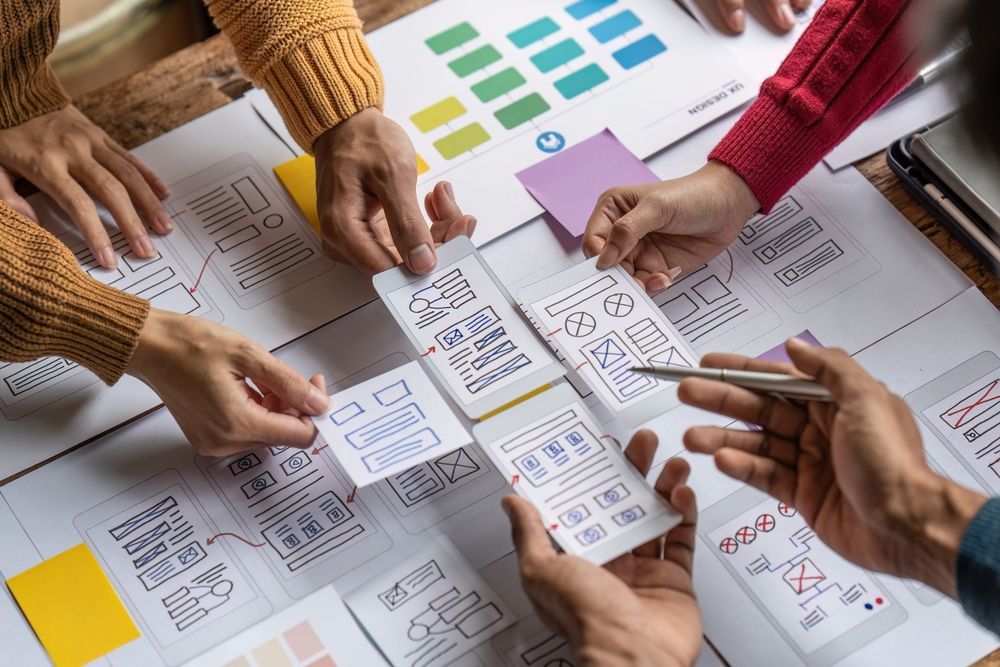Web Wonders: Exploring Innovative Trends in Website Design
In a time of constant digital evolution, website design is going through significant changes. This deep dive delves into the latest innovations shaping web interactions. From minimalist aesthetics to advanced features like AI and VR, this blog uncovers trends setting the stage for online experiences. Discover how these innovations reshape website design and redefine user engagement in the digital realm.
The Dynamic Landscape of Website Design
Emergence of Minimalist Design
The current landscape of website design champions simplicity, focusing on minimalist aesthetics that prioritize content over complexity. This trend towards minimalism not only makes websites more navigable for users but also emphasizes the core message without unnecessary distractions. The sleek, clean designs are visually appealing and significantly enhance the user experience, encouraging longer engagement times and facilitating a more intuitive interaction with the site's features.
The Integration of Artificial Intelligence
Artificial Intelligence (AI) is revolutionizing website design by making interactions smarter and more personalized. From chatbots that provide instant customer service to AI-driven analytics predicting user behavior, the inclusion of AI technologies is setting a new standard for user engagement. These innovations allow for a more tailored browsing experience, adapting to the user's needs in real-time and providing relevant content or suggestions, thus increasing the efficiency and effectiveness of online platforms.
The Advent of Virtual Reality
Virtual Reality (VR) is another groundbreaking technology making its way into web design, offering immersive experiences that were once thought impossible. By integrating VR, websites can transport users into three-dimensional environments, offering interactive tours, virtual try-ons, and educational simulations. This not only captivates users but also significantly boosts interactivity, setting a new bar for what is possible within the realm of online user experience.
The dynamic landscape of website design is continuously evolving, with minimalism, AI, and VR at the forefront of this transformation. These changes are not only reshaping the aesthetics and functionality of websites but also redefining the way users interact with online content.

Embracing Minimalism: Clean and Intuitive User Interfaces
The Essence of Minimalism in Web Design
Minimalism in web design is all about eliminating the superfluous and focusing on what is essential. This approach not only declutters the visual aspect of a website but also streamlines the user's navigation process, making it more intuitive and efficient. A minimalist design ethos underscores the importance of content, with a keen emphasis on typography, color palettes, and spacing that enhance readability and user engagement.
Advantages of Minimalist User Interfaces
Minimalist user interfaces (UI) offer a plethora of advantages, both from an aesthetic and functional perspective. Visually, they provide a modern and sophisticated look that appeals to contemporary users. Functionally, they facilitate a smoother user experience by reducing loading times, enhancing website performance, and making the navigation process straightforward. This simplicity allows users to focus on the website's content and objectives without being overwhelmed by intrusive design elements or complex navigation paths.
Implementing Minimalism in Web Design
To effectively implement minimalism in web design, it's crucial to adopt a 'less is more' approach. This starts with a clear hierarchy of information, highlighting key elements through contrast and alignment. Efficient use of negative space, also known as white space, plays a crucial role in creating a breathing room around content, making it easier to digest. Additionally, selecting a limited color scheme and simple, legible typography can significantly enhance the minimalist appeal of a website without sacrificing its personality or brand identity.
By embracing minimalism, web designers can create clean, intuitive user interfaces that not only appeal to the visual sensibilities of users but also enhance their overall online experience.
Mobile-First Design: Optimizing Websites for On-the-Go Users
The Importance of Mobile-First Design
In today's digital age, the majority of online browsing occurs on mobile devices, making mobile-first design not just an option but a necessity. This approach prioritizes the optimization of websites for smaller screens, ensuring that content is easily accessible, readable, and navigable on smartphones and tablets. By designing for mobile users from the outset, companies can deliver a seamless and cohesive user experience, regardless of device.
Key Principles of Mobile-First Design
Mobile-first design hinges on several key principles to achieve optimal performance on mobile devices. Foremost among these is the concept of responsive design, which allows websites to adapt fluidly to the screen size of any device. This adaptability ensures that users have a consistent experience, enhancing user satisfaction and engagement. Simplicity in design and navigation is equally critical, as mobile screens offer limited real estate. Moreover, the mobile-first design prioritizes fast loading times and touch-friendly interfaces, accommodating the unique navigation methods of mobile users.
Benefits of Adopting Mobile-First Strategies
The benefits of adopting a mobile-first strategy are multifold. Primarily, it improves the user experience for mobile users, who represent a significant portion of internet traffic. This can lead to increased engagement, lower bounce rates, and higher conversion rates. From an SEO perspective, mobile-first design is also advantageous, as Google employs mobile-first indexing, meaning it predominantly uses the mobile version of the content for indexing and ranking. This can significantly boost a website’s visibility and searchability online.
By incorporating mobile-first design principles, websites can ensure they meet the demands of modern internet users, providing a smooth, accessible, and engaging online experience across all devices.

Responsive Web Design: Ensuring Compatibility Across Devices
- Core Concept: Responsive web design (RWD) revolves around creating websites that provide an optimal viewing experience across a wide range of devices, from desktop monitors to mobile phones. It's about ensuring that users have a seamless interaction with a site, no matter what device they're using.
- Fluid Grids: At the heart of RWD lie fluid grid systems. These grids use percentages for widths instead of fixed units like pixels, allowing the layout to adapt to the screen size dynamically.
- Flexible Images: Alongside fluid grids, responsive design employs flexible images that scale within their container elements. This ensures that images don't break the layout or look disproportionate on different devices.
- Media Queries: Media queries are a pivotal CSS feature used in RWD. They enable the webpage to use different CSS style rules based on the characteristics of the device, primarily the width of the browser.
- Enhanced User Experience: The ultimate goal of responsive web design is to enhance the user experience by delivering content in the most accessible and optimal way possible. This minimizes panning, scrolling, and resizing efforts for the user.
- SEO Benefits: Responsive websites have a single URL and the same HTML across devices, which makes it easier for search engines to crawl and index the content. This uniformity significantly improves a site's SEO performance.
- Cost-Effective: Maintaining one responsive website is less costly and time-consuming than maintaining separate sites for desktop and mobile users. It represents a cost-effective approach to web design.
- Future Scalability: Responsive design means a website is prepared for the future. With the advent of new devices and screen sizes, a responsive website can adapt to these changes more readily than a fixed-width website.
Interactive Elements: Enhancing User Engagement with Animation
The Role of Animation in Web Design
Animations in web design are not just about aesthetics; they play a critical role in enhancing user engagement and guiding user interactions. Through subtle movements and transitions, animations can direct users' attention to important elements, making the interface more intuitive and dynamic. When implemented thoughtfully, animations can transform a static webpage into an immersive interactive experience, making the user's journey through the site both engaging and entertaining.
Types of Web Animation
- Microinteractions: These are small, functional animations that support the user's interactions with a website. Examples include button animations that confirm a click or a small loader animation that indicates processing. Microinteractions add a layer of polish and feedback to user actions, enhancing the overall usability of the site.
- Transition Effects: Transition effects are used to smoothly guide users from one state or page to another. These can be implemented to soften the otherwise abrupt nature of navigating between different sections of a website, improving the flow and continuity of the user experience.
- Data Visualization: Animations can bring static data to life, making complex information more digestible and engaging. Animated charts, graphs, and counters help convey data in a dynamic and visually appealing manner, increasing comprehension and retention.
Best Practices for Using Animation in Web Design
- Purposeful Animation: Every animation should serve a purpose, whether it's to enhance user experience, guide user actions, or visualize data. Avoid using animation purely for decoration as it can distract and detract from the website's main objectives.
- Performance Optimization: While animations can enhance a site, they can also negatively impact its performance if not properly optimized. It's important to ensure that animations are smooth and do not cause lag, which can frustrate users and lead to a poor experience.
- Accessibility Considerations: Designers must consider users with motion sensitivities or other disabilities. Providing options to reduce motion or disable animations can make the website more accessible and inclusive.
Incorporating animations into web design, when done correctly, can significantly enhance user engagement and interaction. By following best practices and focusing on purposeful animations, designers can create more dynamic, intuitive, and enjoyable online experiences.

Embracing Innovation in Website Design
The digital landscape is continually evolving, and with it, the possibilities for innovative website design. To stay ahead, businesses must adapt to these changes and leverage new technologies and design philosophies to enhance user engagement and improve website performance. Whether through responsive design, mobile-first approaches, or the creative use of animations, the goal remains clear: to deliver an optimal, engaging, and accessible user experience across all devices.
At
LevelUp Digital Solutions, we understand the importance of innovation in achieving digital success. Our team is dedicated to incorporating the latest trends in web design and development to create custom solutions that meet the unique needs of our clients. If you're looking to elevate your online presence and stay ahead in the fast-paced digital world, contact us. Together, we can create a website that not only meets today's demands but is also prepared for tomorrow's opportunities.


















